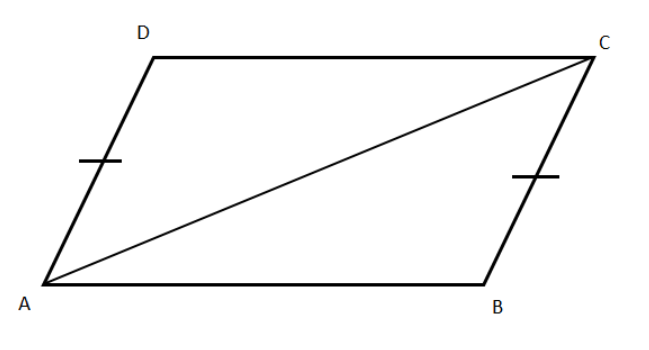
In the given figure if \[AD = BC\] and \[AD\parallel BC\], then:

A. AB = AD
B. AB = DC
C. BC = CD
D. None

Answer
573.9k+ views
Hint: In this question, first of all prove that the triangles ADC and ABC are similar triangles by using SAS congruence rule. The corresponding sides in a similar triangle are in the same ratio. So, use this concept to reach the solution of the given problem.
Complete step-by-step answer:
Given that \[AD = BC\] and \[AD\parallel BC\].
Now, in \[\Delta ADC\] and \[\Delta ABC\] we have
\[
\Rightarrow AD = BC{\text{ }}\left[ {\because {\text{given}}} \right] \\
\Rightarrow \angle ADC = \angle ABC{\text{ }}\left[ {\because AD\parallel BC} \right] \\
\Rightarrow AC = AC{\text{ }}\,{\text{ }}\left[ {\because {\text{common}}} \right] \\
\]
Therefore, by SAS congruence rule \[\Delta ADC \cong \Delta ADC\].
We know that the corresponding sides in similar triangle are in same ratio. So, we have
\[\dfrac{{AD}}{{BC}} = \dfrac{{DC}}{{AB}}\]
Since, \[AD = BC\] we have
\[
\Rightarrow \dfrac{{AD}}{{AD}} = \dfrac{{DC}}{{AB}} \\
\Rightarrow 1 = \dfrac{{DC}}{{AB}} \\
\therefore AB = DC \\
\]
Thus, the correct option is B. AB = DC
Note: The SAS congruence rule states that two triangles are said to be similar if two sides and the included angle of one triangle are equal to two sides and included angle of another triangle. The symbol of similarity is ‘\[ \cong \]’.
Complete step-by-step answer:
Given that \[AD = BC\] and \[AD\parallel BC\].
Now, in \[\Delta ADC\] and \[\Delta ABC\] we have
\[
\Rightarrow AD = BC{\text{ }}\left[ {\because {\text{given}}} \right] \\
\Rightarrow \angle ADC = \angle ABC{\text{ }}\left[ {\because AD\parallel BC} \right] \\
\Rightarrow AC = AC{\text{ }}\,{\text{ }}\left[ {\because {\text{common}}} \right] \\
\]
Therefore, by SAS congruence rule \[\Delta ADC \cong \Delta ADC\].
We know that the corresponding sides in similar triangle are in same ratio. So, we have
\[\dfrac{{AD}}{{BC}} = \dfrac{{DC}}{{AB}}\]
Since, \[AD = BC\] we have
\[
\Rightarrow \dfrac{{AD}}{{AD}} = \dfrac{{DC}}{{AB}} \\
\Rightarrow 1 = \dfrac{{DC}}{{AB}} \\
\therefore AB = DC \\
\]
Thus, the correct option is B. AB = DC
Note: The SAS congruence rule states that two triangles are said to be similar if two sides and the included angle of one triangle are equal to two sides and included angle of another triangle. The symbol of similarity is ‘\[ \cong \]’.
Recently Updated Pages
Master Class 12 Economics: Engaging Questions & Answers for Success

Master Class 12 Maths: Engaging Questions & Answers for Success

Master Class 12 Biology: Engaging Questions & Answers for Success

Master Class 12 Physics: Engaging Questions & Answers for Success

Master Class 8 Maths: Engaging Questions & Answers for Success

Class 8 Question and Answer - Your Ultimate Solutions Guide

Trending doubts
Why is there a time difference of about 5 hours between class 10 social science CBSE

Write a letter to the principal requesting him to grant class 10 english CBSE

What is the median of the first 10 natural numbers class 10 maths CBSE

The Equation xxx + 2 is Satisfied when x is Equal to Class 10 Maths

Which of the following does not have a fundamental class 10 physics CBSE

State and prove converse of BPT Basic Proportionality class 10 maths CBSE




